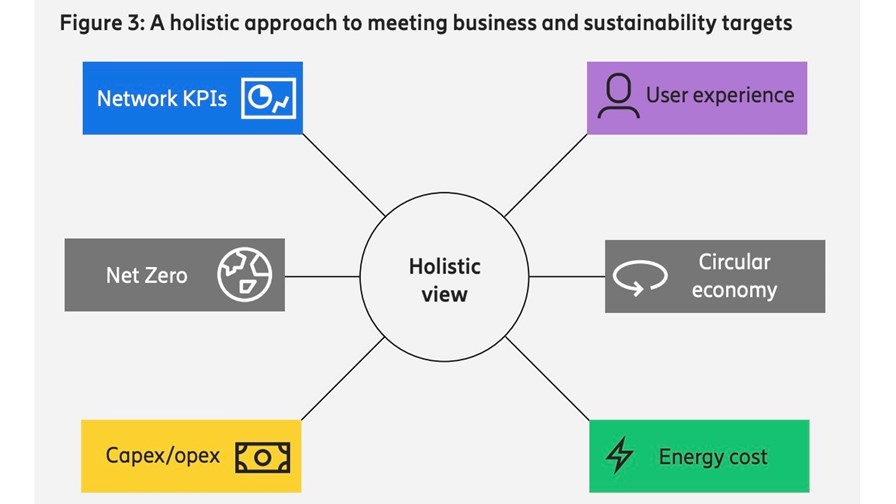
Source: Ericsson Breaking the Energy Curve Report 2022
- The energy costs associated with running the world’s mobile networks are set to exceed $25bn annually due to the ongoing crisis and inflation, according to Ericsson
- Telcos are urged to modernise their radio access networks, the most energy-hungry and costly part of their infrastructure
- The use of artificial intelligence and machine learning can help improve energy-efficiency efforts
Communications service providers (CSPs) need to take a more comprehensive approach to reducing the amount of energy consumed by their mobile networks, including modernising them with the use of data and artificial intelligence (AI), as an alarming new forecast by Ericsson suggests the annual energy cost to run the world’s mobile networks will surpass $25bn.
In a new Breaking the Energy Curve report, an update of its initial publication from 2020, the Swedish telecoms network equipment vendor explained that an earlier forecast, which estimated the power consumption costs of the world’s cellular networks to be about $25bn, is now outdated and operators should brace for higher costs.
“The ongoing energy crisis has resulted in increased and volatile energy prices, and we are seeing short-term large impacts in certain areas, like Europe. What we can expect is that with the current energy crisis and inflation, the previous already high cost to operators already has increased – and should be expected to increase further”, an Ericsson spokesperson told TelecomTV.
Ericsson isn’t alone in issuing this warning. According to GSMA Intelligence, energy consumption accounted for between 15% and 40% of operators’ operating expenditure (opex) in 2021, but that figure is expected to increase in the next few years.
To counter the gloomy prognosis, the company recommends that telcos make sustainability “top of mind” when building out their 5G networks.
More precisely, CSPs should focus on continuous energy savings across their radio access network (RAN) products and solutions, which consume the most energy of any part of a mobile network. According to Ericsson’s findings, the RAN, with its active and passive equipment, accounts for more than 75% of the service provider’s network energy consumption.
RAN energy efficiency, as the company puts it, is “the only way to keep energy consumption under control, while delivering an excellent user experience”. The vendor goes on to suggest that operators could use energy metering to observe their actual energy consumption inside the RAN and take action to reduce it.
Ericsson also recommended that telcos modernise their existing networks and maximise traffic performance through tools and capabilities, such as AI and machine learning (ML), in addition to automation solutions. It claims these capabilities can lead to reduced energy usage and a lower carbon footprint.
It warns, however, that expanding sites with new 5G solutions is linked to deploying new frequency bands and requires adding equipment which increases energy use.
“To avoid increasing energy consumption, the installed equipment needs to be modernised. This is key to changing the energy consumption trajectory in mobile networks. With a combined view of investments and operating costs, our latest generations of multi-band and massive multiple-input and multiple-output (MIMO) radios and basebands can help service providers to cut energy consumption and greatly improve their energy costs and total cost of ownership going forward,” the report maintained.
According to Ericsson, mobile operators also need to use energy-saving applications to adjust network capacity so that it matches demand and provides “the best user experience with the lowest energy use” possible.
The Swedish network vendor also appealed for “a holistic view of network evolution, expansion and operation” to break the energy curve.
“We cannot continue with a business-as-usual approach. We should take advantage of wider network changes and modernisation as opposed to piecemeal swap-outs. We must utilise the latest advances in technology to enable energy-saving functionalities and consider the best use of our energy sources. To put it simply, we need to think differently,” said Ericsson’s EVP and head of business area networks Fredrik Jejdling.
Looking more broadly at the ICT industry, Ericsson claimed that if the sector switched to renewable sources for all its electricity needs, carbon emissions could be reduced by 80%.
- Yanitsa Boyadzhieva, Deputy Editor, TelecomTV
Email Newsletters
Sign up to receive TelecomTV's top news and videos, plus exclusive subscriber-only content direct to your inbox.




